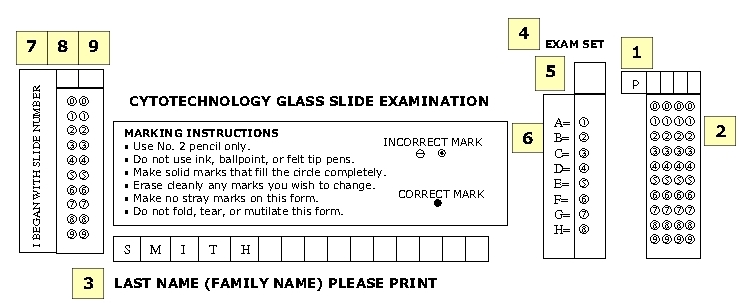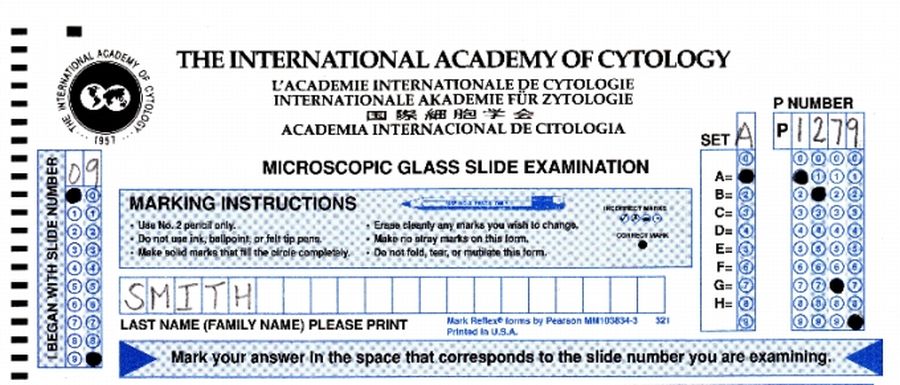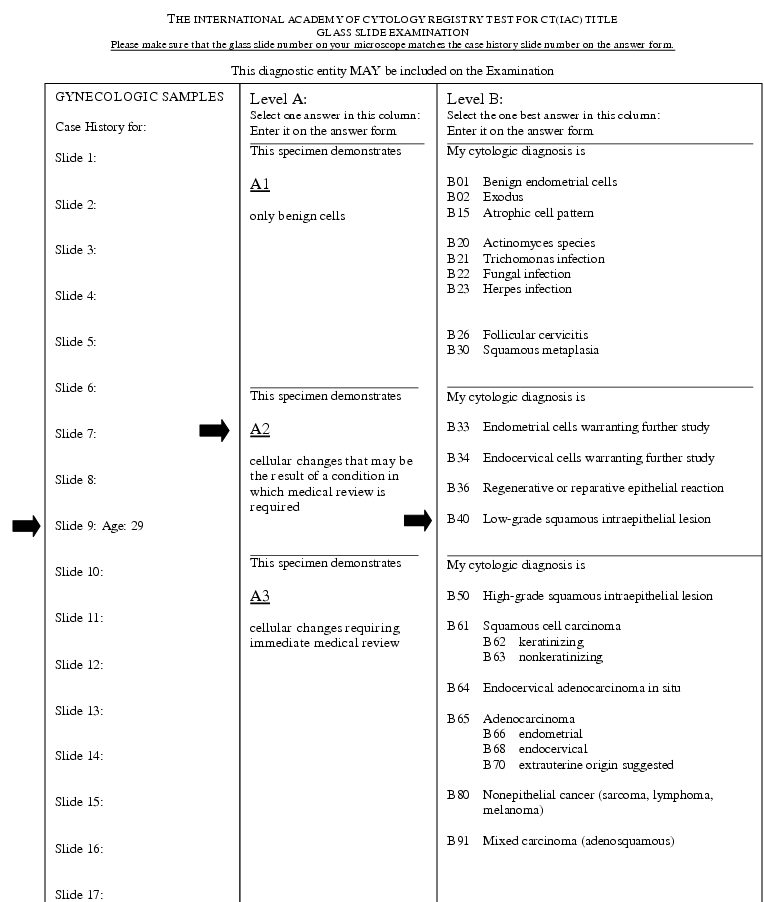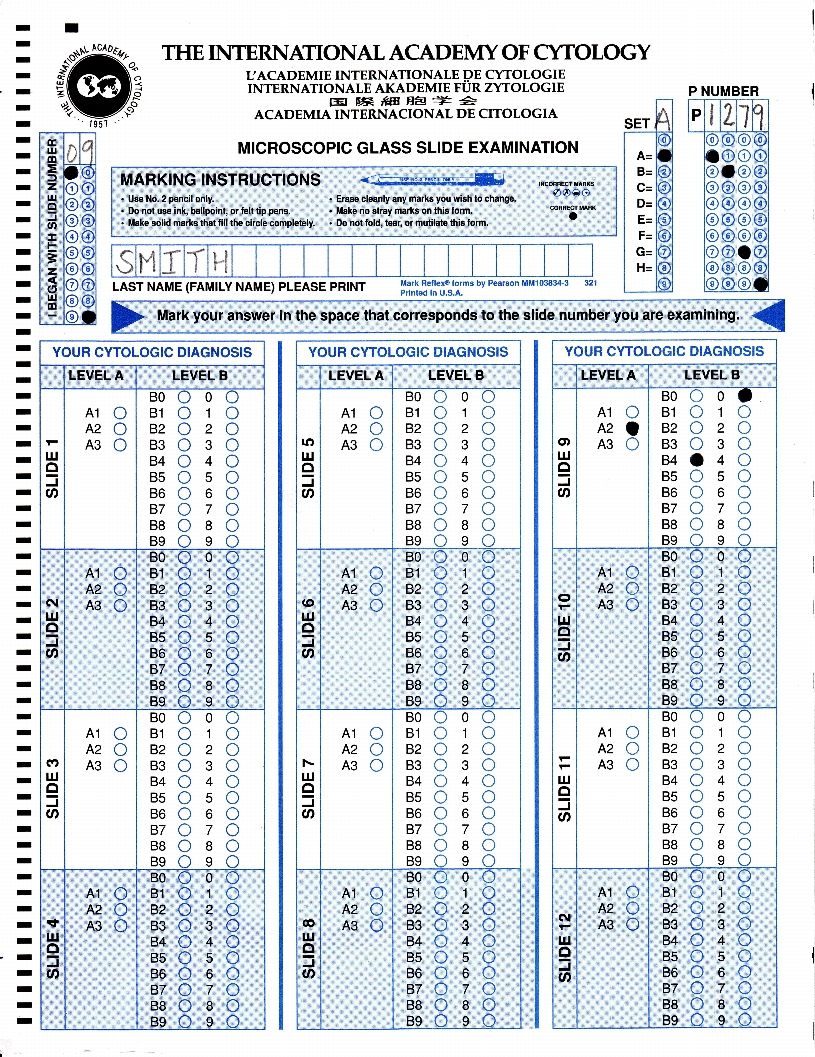The CT(IAC) comprehensive cytotechnology examination is voluntary. Its purpose is to emphasize the continuing education process that must be present if one is a professional in a scientific, health-related field of study. This examination is one method of measuring your proficiency in cytology after working in the field for three or more years. Passing the examination is evidence that you have achieved a measure of proficiency and knowledge as a cytotechnologist. The credential, CT(IAC), after your name will show your fellow workers that you have continued the learning process and that you are committed to earning 180 cytotechnology continuing education points throughout each four year period. You should be very proud of this!
No one really likes to take an examination but we can help by explaining the format to you.
The examination is in three parts. All are mulitple choice format.
Microscope with glass slides
This includes a sheet providing a choice of 3 answers (Level A) and depending upon your choice a further selection for better definition (Level B)
An answer sheet that needs your name and P number. This is where you note the answers to BOTH level A and level B
Projected Visual Images
This includes a question sheet with a question for each image. There is a choice of answers
An answer sheet that needs your name and P number. This is where you note your answer
Written
This includes a sheet of 80 multiple choice questions
An answer sheet that needs your name and P number. This is where you note your answers.
BEFORE YOU START

- Write your identification “P” number in the squares at the top right of this form
- Fill in the circled number to correspond with your identification “P” number
- Print in clear letters your last name (Family name) in the squares provided starting at the left, one letter per square.
- You will be informed of the EXAM SET letter to fill in
- Print this letter in the EXAM SET square
- Fill in the circle to correspond with the exam set letter
- Look at the number on the glass slide next to your microscope
- Write this number in the I BEGAN WITH SLIDE NUMBER space provided. Not everyone can begin with slide number 1. If you begin with slide number 9 then your last slide will be number 8. Please note, a single number should have a 0 infront for example 9 = 09.
- Please fill in the circled numbers below to correspond with this slide. Note, once again single number as preceded with a 0, 9 = 09.
- Check that the number on your slide matches the case history number on the diagnostic form.
For example, if you have slide number 9 look at the case history and type of cell sample that belongs to slide number 9.
Please note: If you should change your mind, carefully erase the pencil marks within the circle and mark your second choice in the new circle. Please do not make holes in the paper when you erase.

An example of a completed form.
GLASS SLIDE EXAMINATION – 90 MINUTES – 30 GLASS SLIDES
As well as the answering sheet with your name and P number you will receive a diagnosic sheet with multiple choice answers. All questions will be given to you in the language you indicated on your application form.
Each slide has a number and you must look at the case history numbers for this slide number and then make your choices.
Each glass slide and question can be viewed for three minutes before the command to pass along. The slides are marked with circles.
You will be informed when to begin and when to pass by the exam monitor.
The multiple choice diagnostic answer sheet is in three columns
Column One
lists the type of cell.sample, the slide number, the age and sex of the patient and pertinent clinical history.
Column Two (Level A)
contains the first choice your must make regarding the circled cells. A selection must be made from level A or it will be considered a missed case.
Column Three (Level B)
contains the specific cytologic diagnostic choice. Only ONE diagnostic choice is possible.
For the purpose of the example below assume that the first slide you examine during the examination is Slide 9. You decide that the circled cells on Slide 9 (a gynecologic cell sample of a 29 year old patient) would represent low-grade squamous intraepithelial lesion. Under column two (Level A) your choice would be A2. Under column three (Level B) your choice would be B40.
GLASS SLIDE EXAMINATION – 90 MINUTES – 30 GLASS SLIDES
As well as the answering sheet with your name and P number you will receive a diagnosic sheet with multiple choice answers. All questions will be given to you in the language you indicated on your application form.
Each slide has a number and you must look at the case history numbers for this slide number and then make your choices.
Each glass slide and question can be viewed for three minutes before the command to pass along. The slides are marked with circles.
You will be informed when to begin and when to pass by the exam monitor.
The multiple choice diagnostic answer sheet is in three columns
Column One
lists the type of cell sample, the slide number, the age and sex of the patient and pertinent clinical history.
Column Two (Level A)
contains the first choice your must make regarding the circled cells. A selection must be made from level A or it will be considered a missed case.
Column Three (Level B)
contains the specific cytologic diagnostic choice. Only ONE diagnostic choice is possible.
For the purpose of the example below assume that the first slide you examine during the examination is Slide 9. You decide that the circled cells on Slide 9 (a gynecologic cell sample of a 29 year old patient) would represent low-grade squamous intraepithelial lesion. Under column two (Level A) your choice would be A2. Under column three (Level B) your choice would be B40.

And this is how the answer sheet is filled in
